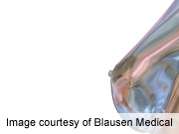Review quantifies benefits, harms of mammography

(HealthDay)—The benefits and harms of screening mammography have been quantified in a special communication published online Dec. 30 in JAMA Internal Medicine.
H. Gilbert Welch, M.D., M.P.H., and Honor J. Passow, Ph.D., from the Dartmouth Institute for Health Policy and Clinical Practice in Hanover, N.H., provide a range of estimates for the absolute frequency of breast cancer deaths avoided, false alarms, and overdiagnosis associated with screening mammography. Data were used from nine randomized trials and are specific to the United States.
The researchers found that, among 1,000 U.S. women aged 50 years who underwent annual screening for 10 years, 0.3 to 3.2 will avoid a breast cancer death; 490 to 670 will experience one or more false alarms; and overdiagnosis and needless treatment will affect three to 14.
"We hope that these data are sufficient for some women to make the decision about whether or not to be screened," the authors conclude. "Some may choose to pursue screening, valuing any potential for benefit as warranting the accompanying harms. Others may choose not to pursue screening, valuing the plausible range for the magnitude of the harms as being too great to justify pursuing the relatively small benefit."
More information:
Abstract
Full Text
Copyright © 2013 HealthDay. All rights reserved.














